

Compact Muon Solenoid
LHC, CERN
| CMS-EXO-16-049 ; CERN-EP-2018-183 | ||
| Search for dark matter particles produced in association with a top quark pair at $\sqrt{s} = $ 13 TeV | ||
| CMS Collaboration | ||
| 18 July 2018 | ||
| Phys. Rev. Lett. 122 (2019) 011803 | ||
| Abstract: A search is performed for dark matter particles produced in association with a top quark pair in proton-proton collisions at $\sqrt{s} = $ 13 TeV. The data correspond to an integrated luminosity of 35.9 fb$^{-1}$ recorded by the CMS detector at the LHC. No significant excess over the standard model expectation is observed. The results are interpreted using simplified models of dark matter production via spin-0 mediators that couple to dark matter particles and to standard model quarks, providing constraints on the coupling strength between the mediator and the quarks. These are the most stringent collider limits to date for scalar mediators, and the most stringent for pseudoscalar mediators at low masses. | ||
| Links: e-print arXiv:1807.06522 [hep-ex] (PDF) ; CDS record ; inSPIRE record ; CADI line (restricted) ; | ||
| Figures | |
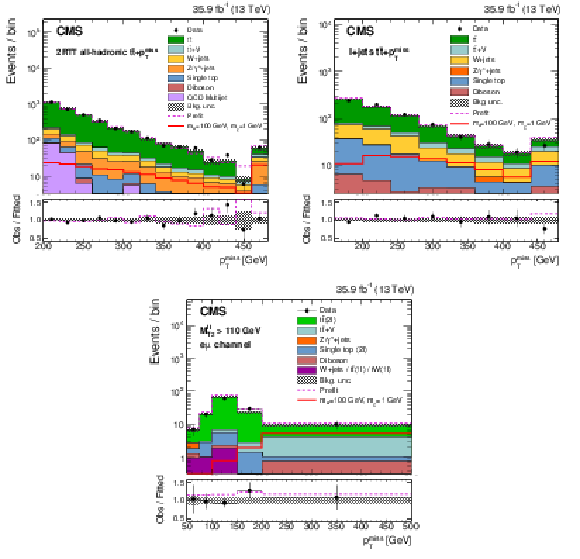
png pdf |
Figure 1:
Selected $ {{p_{\mathrm {T}}} ^\text {miss}} $ distributions in SRs: 2RTT SR for the all-hadronic (upper left), the $\ell $+jets (upper right), and the different-flavor, $ {{m_{\mathrm {T2}}} ^{\ell \ell}} > $ 110 GeV SR in the dileptonic channel (lower). The solid red line shows the expectation for a signal with $m_ {\mathrm {a}} = $ 100 GeV and $m_{\chi} = $ 1 GeV. The last bin contains the overflow events. The lower panel shows the ratio of the observed to the fitted distribution (points), and the ratio of the background expectation before the fit to the fitted distribution (dashed magenta line). The vertical bars indicate the statistical uncertainty on the data. The horizontal bars on the rightmost plot indicate the bin width. The uncertainty bands in both panels include the statistical and systematic uncertainties on the total background. |
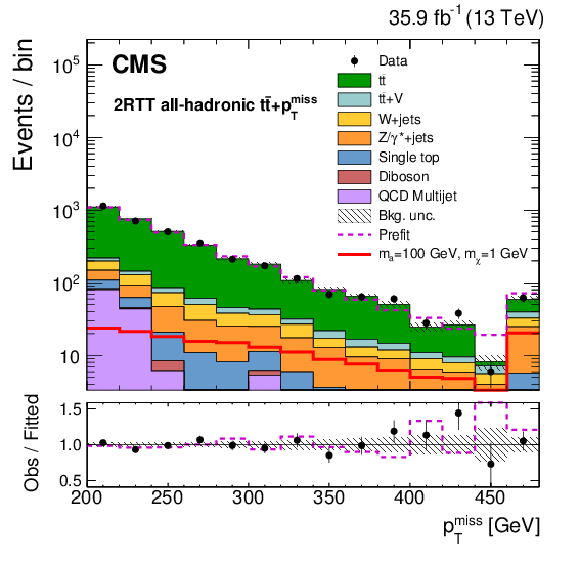
png pdf |
Figure 1-a:
Selected $ {{p_{\mathrm {T}}} ^\text {miss}} $ distributions in SRs: 2RTT SR for the all-hadronic. The solid red line shows the expectation for a signal with $m_ {\mathrm {a}} = $ 100 GeV and $m_{\chi} = $ 1 GeV. The last bin contains the overflow events. The lower panel shows the ratio of the observed to the fitted distribution (points), and the ratio of the background expectation before the fit to the fitted distribution (dashed magenta line). The vertical bars indicate the statistical uncertainty on the data. The horizontal bars on the rightmost plot indicate the bin width. The uncertainty bands in both panels include the statistical and systematic uncertainties on the total background. |
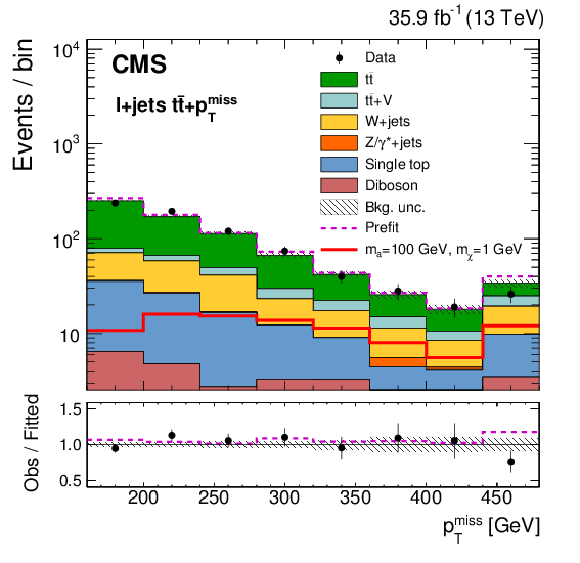
png pdf |
Figure 1-b:
Selected $ {{p_{\mathrm {T}}} ^\text {miss}} $ distributions in SRs: 2RTT SR for the $\ell $+jets. The solid red line shows the expectation for a signal with $m_ {\mathrm {a}} = $ 100 GeV and $m_{\chi} = $ 1 GeV. The last bin contains the overflow events. The lower panel shows the ratio of the observed to the fitted distribution (points), and the ratio of the background expectation before the fit to the fitted distribution (dashed magenta line). The vertical bars indicate the statistical uncertainty on the data. The horizontal bars on the rightmost plot indicate the bin width. The uncertainty bands in both panels include the statistical and systematic uncertainties on the total background. |

png pdf |
Figure 1-c:
Selected $ {{p_{\mathrm {T}}} ^\text {miss}} $ distributions in SRs: 2RTT SR for the different-flavor, $ {{m_{\mathrm {T2}}} ^{\ell \ell}} > $ 110 GeV SR in the dileptonic channel. The solid red line shows the expectation for a signal with $m_ {\mathrm {a}} = $ 100 GeV and $m_{\chi} = $ 1 GeV. The last bin contains the overflow events. The lower panel shows the ratio of the observed to the fitted distribution (points), and the ratio of the background expectation before the fit to the fitted distribution (dashed magenta line). The vertical bars indicate the statistical uncertainty on the data. The horizontal bars on the rightmost plot indicate the bin width. The uncertainty bands in both panels include the statistical and systematic uncertainties on the total background. |

png pdf |
Figure 2:
The exclusion limits at 95% CL on the signal strength $\mu =\sigma /\sigma _{\text {th}}$ computed as a function of the mediator and dark matter mass, assuming a scalar (left) and pseudoscalar (right) mediator. The mediator couplings are assumed to be $ {{\mathrm {g}} _{{\mathrm {q}}}} = {\mathrm {g}} _{\chi}=$ 1. The dashed magenta lines represent the 68% probability interval around the expected limit. The observed limit contour is almost coincident with the boundary of the 68% probability interval. |

png pdf |
Figure 2-a:
The exclusion limits at 95% CL on the signal strength $\mu =\sigma /\sigma _{\text {th}}$ computed as a function of the mediator and dark matter mass, assuming a scalar mediator. The mediator couplings are assumed to be $ {{\mathrm {g}} _{{\mathrm {q}}}} = {\mathrm {g}} _{\chi}=$ 1. The dashed magenta lines represent the 68% probability interval around the expected limit. The observed limit contour is almost coincident with the boundary of the 68% probability interval. |
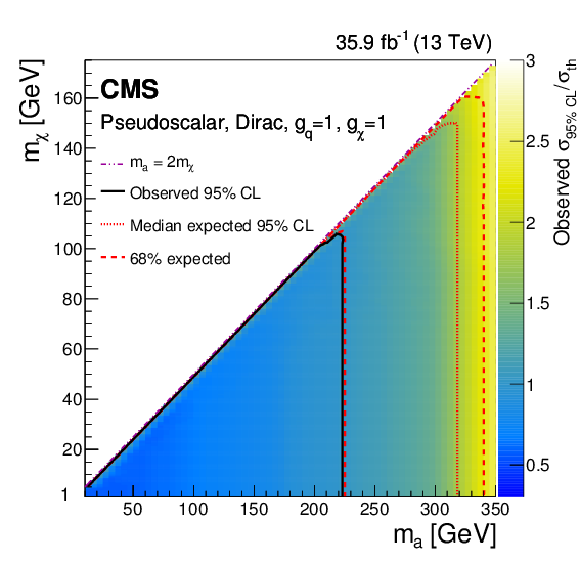
png pdf |
Figure 2-b:
The exclusion limits at 95% CL on the signal strength $\mu =\sigma /\sigma _{\text {th}}$ computed as a function of the mediator and dark matter mass, assuming a pseudoscalar mediator. The mediator couplings are assumed to be $ {{\mathrm {g}} _{{\mathrm {q}}}} = {\mathrm {g}} _{\chi}=$ 1. The dashed magenta lines represent the 68% probability interval around the expected limit. The observed limit contour is almost coincident with the boundary of the 68% probability interval. |

png pdf |
Figure 3:
The 95% observed and median expected CL upper limits on the coupling strength of the mediator to the standard model quarks under the assumption that $ {\mathrm {g}} _{\chi}= $ 1. A dark matter particle with a mass of 1 GeV is assumed. The green and yellow bands indicate respectively the 68% and 95% probability intervals around the expected limit. The interpretations for a scalar (left) and a pseudoscalar (right) mediator are shown. |
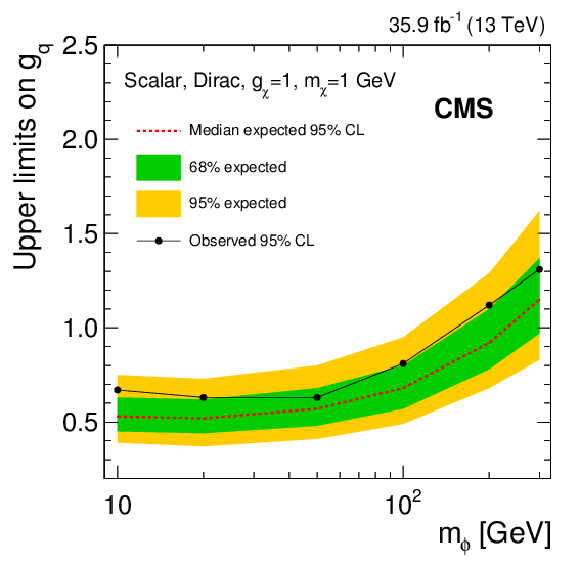
png pdf |
Figure 3-a:
The 95% observed and median expected CL upper limits on the coupling strength of the mediator to the standard model quarks under the assumption that $ {\mathrm {g}} _{\chi}= $ 1. A dark matter particle with a mass of 1 GeV is assumed. The green and yellow bands indicate respectively the 68% and 95% probability intervals around the expected limit. The interpretations for a scalar mediator are shown. |

png pdf |
Figure 3-b:
The 95% observed and median expected CL upper limits on the coupling strength of the mediator to the standard model quarks under the assumption that $ {\mathrm {g}} _{\chi}= $ 1. A dark matter particle with a mass of 1 GeV is assumed. The green and yellow bands indicate respectively the 68% and 95% probability intervals around the expected limit. The interpretations for a pseudoscalar mediator are shown. |
| Summary |
| In summary, a comprehensive search for dark matter particles produced in association with a top quark pair yields no significant excess over the predicted background. The results presented in this Letter provide 30--60% better cross section limits compared to earlier searches targeting the same signature [57,59]. The analysis offers stronger constraints than direct and indirect experiments for dark matter masses of O(10 GeV) and below. Over much of the parameter space, the $\mathrm{ t \bar{t} } + \chi \overline{\chi}$ signature has better sensitivity for spin-0 mediators than dark matter production in association with a jet [14] -- previously considered to be the most sensitive signature. For the pseudoscalar model, the $\mathrm{ t \bar{t} } + \chi \overline{\chi}$ signature provides the most stringent cross section constraints for mediator masses of around 200 GeV and below. The observed (expected) limits exclude a pseudoscalar mediator with mass below 220 (320) GeV under the $\mathrm{g}_{\mathrm{q}}=\mathrm{g}_{\chi}=$ 1 benchmark scenario. The $\mathrm{ t \bar{t} } + \chi \overline{\chi}$ signature provides the best sensitivity for the scalar mediator model and is currently the only collider signature that is sufficiently sensitive to exclude regions of parameter space with these values of the couplings. The observed exclusion of a mediator with mass below 160 GeV (240 GeV expected) provides the most stringent constraint to date on this model. |
| References | ||||
| 1 | G. Bertone, D. Hooper, and J. Silk | Particle dark matter: evidence, candidates and constraints | PR 405 (2005) 279 | hep-ph/0404175 |
| 2 | J. L. Feng | Dark matter candidates from particle physics and methods of detection | Ann. Rev. Astron. Astrophys. 48 (2010) 495 | 1003.0904 |
| 3 | T. A. Porter, R. P. Johnson, and P. W. Graham | Dark matter searches with astroparticle data | Ann. Rev. Astron. Astrophys. 49 (2011) 155 | 1104.2836 |
| 4 | G. Bertone et al. | Identifying WIMP dark matter from particle and astroparticle data | JCAP 03 (2018) 026 | 1712.04793 |
| 5 | U. Haisch, F. Kahlhoefer, and J. Unwin | The impact of heavy-quark loops on LHC dark matter searches | JHEP 07 (2013) 125 | 1208.4605 |
| 6 | T. Lin, E. W. Kolb, and L.-T. Wang | Probing dark matter couplings to top and bottom quarks at the LHC | PRD 88 (2013) 063510 | 1303.6638 |
| 7 | M. R. Buckley, D. Feld, and D. Gon\ifmmode \mbox\cc\else \cc\fialves | Scalar simplified models for dark matter | PRD 91 (2015) 015017 | 1410.6497 |
| 8 | U. Haisch and E. Re | Simplified dark matter top-quark interactions at the LHC | JHEP 06 (2015) 078 | 1503.00691 |
| 9 | C. Arina et al. | A comprehensive approach to dark matter studies: exploration of simplified top-philic models | JHEP 11 (2016) 111 | 1605.09242 |
| 10 | ATLAS Collaboration | Search for new phenomena in final states with an energetic jet and large missing transverse momentum in pp collisions at $ \sqrt{s}= $ 8 TeV with the ATLAS detector | EPJC 75 (2015) 299 | 1502.01518 |
| 11 | CMS Collaboration | Search for dark matter in proton-proton collisions at 8 TeV with missing transverse momentum and vector boson tagged jets | JHEP 12 (2016) 083 | CMS-EXO-12-055 1607.05764 |
| 12 | ATLAS Collaboration | Search for new phenomena in final states with an energetic jet and large missing transverse momentum in pp collisions at $ \sqrt{s}= $ 13 TeV using the ATLAS detector | PRD 94 (2016) 032005 | 1604.07773 |
| 13 | CMS Collaboration | Search for dark matter produced with an energetic jet or a hadronically decaying W or Z boson at $ \sqrt{s} = $ 13 TeV | JHEP 07 (2017) 14 | CMS-EXO-16-037 1703.01651 |
| 14 | CMS Collaboration | Search for new physics in final states with an energetic jet or a hadronically decaying W or Z boson and transverse momentum imbalance at $ \sqrt{s}= $ 13 TeV | PRD 97 (2018) 092005 | CMS-EXO-16-048 1712.02345 |
| 15 | CMS Collaboration | Search for the production of dark matter in association with top-quark pairs in the single-lepton final state in proton-proton collisions at $ \sqrt{s} = $ 8 TeV | JHEP 06 (2015) 121 | CMS-B2G-14-004 1504.03198 |
| 16 | ATLAS Collaboration | Search for dark matter in events with heavy quarks and missing transverse momentum in pp collisions with the ATLAS detector | EPJC 75 (2015) 92 | 1410.4031 |
| 17 | CMS Collaboration | Search for dark matter produced in association with heavy-flavor quark pairs in proton-proton collisions at $ \sqrt{s}= $ 13 TeV | EPJC 77 (2017) 845 | CMS-EXO-16-005 1706.02581 |
| 18 | CMS Collaboration | The CMS trigger system | JINST 12 (2017) P01020 | CMS-TRG-12-001 1609.02366 |
| 19 | CMS Collaboration | The CMS experiment at the CERN LHC | JINST 3 (2008) S08004 | CMS-00-001 |
| 20 | CMS Collaboration | Particle-flow reconstruction and global event description with the CMS detector | JINST 12 (2017) P10003 | CMS-PRF-14-001 1706.04965 |
| 21 | M. Cacciari, G. P. Salam, and G. Soyez | The anti-$ {k_{\mathrm{T}}} $ jet clustering algorithm | JHEP 04 (2008) 063 | 0802.1189 |
| 22 | M. Cacciari, G. P. Salam, and G. Soyez | FastJet user manual | EPJC 72 (2012) 1896 | 1111.6097 |
| 23 | CMS Collaboration | Determination of jet energy calibration and transverse momentum resolution in CMS | JINST 6 (2011) 11002 | CMS-JME-10-011 1107.4277 |
| 24 | M. Cacciari, G. P. Salam, and G. Soyez | The catchment area of jets | JHEP 04 (2008) 005 | 0802.1188 |
| 25 | CMS Collaboration | Jet algorithms performance in 13 TeV data | CMS-PAS-JME-16-003 | CMS-PAS-JME-16-003 |
| 26 | CMS Collaboration | Identification of heavy-flavour jets with the CMS detector in pp collisions at 13 TeV | JINST 13 (2018) P05011 | CMS-BTV-16-002 1712.07158 |
| 27 | CMS Collaboration | Performance of electron reconstruction and selection with the CMS Detector in proton-proton Collisions at $ \sqrt{s}= $ 8 TeV | JINST 10 (2015) P06005 | CMS-EGM-13-001 1502.02701 |
| 28 | P. Nason | A new method for combining NLO QCD with shower Monte Carlo algorithms | JHEP 11 (2004) 040 | hep-ph/0409146 |
| 29 | S. Frixione, P. Nason, and C. Oleari | Matching NLO QCD computations with parton shower simulations: the POWHEG method | JHEP 11 (2007) 070 | 0709.2092 |
| 30 | S. Alioli, P. Nason, C. Oleari, and E. Re | A general framework for implementing NLO calculations in shower Monte Carlo programs: the POWHEG BOX | JHEP 06 (2010) 043 | 1002.2581 |
| 31 | C. Oleari | The POWHEG-BOX | NPPS 205-206 (2010) 36 | 1007.3893 |
| 32 | J. Alwall et al. | The automated computation of tree-level and next-to-leading order differential cross sections, and their matching to parton shower simulations | JHEP 07 (2014) 079 | 1405.0301 |
| 33 | A. Denner, S. Dittmaier, T. Kasprzik, and A. Muck | Electroweak corrections to W+jet hadroproduction including leptonic W-boson decays | JHEP 08 (2009) 075 | 0906.1656 |
| 34 | A. Denner, S. Dittmaier, T. Kasprzik, and A. Muck | Electroweak corrections to dilepton+jet production at hadron colliders | JHEP 06 (2011) 069 | 1103.0914 |
| 35 | A. Denner, S. Dittmaier, T. Kasprzik, and A. Maeck | Electroweak corrections to monojet production at the LHC | EPJC 73 (2013) 2297 | 1211.5078 |
| 36 | J. H. Kuhn, A. Kulesza, S. Pozzorini, and M. Schulze | Electroweak corrections to hadronic photon production at large transverse momenta | JHEP 03 (2006) 059 | hep-ph/0508253 |
| 37 | S. Kallweit et al. | NLO electroweak automation and precise predictions for W+multijet production at the LHC | JHEP 04 (2015) 012 | 1412.5157 |
| 38 | S. Kallweit et al. | NLO QCD+EW predictions for V+jets including off-shell vector-boson decays and multijet merging | JHEP 04 (2016) 021 | 1511.08692 |
| 39 | NNPDF Collaboration | Parton distributions for the LHC Run II | JHEP 04 (2015) 040 | 1410.8849 |
| 40 | T. Sjostrand, S. Mrenna, and P. Z. Skands | A brief introduction to PYTHIA 8.1 | CPC 178 (2008) 852 | 0710.3820 |
| 41 | CMS Collaboration | Event generator tunes obtained from underlying event and multiparton scattering measurements | EPJC 76 (2016) 155 | CMS-GEN-14-001 1512.00815 |
| 42 | GEANT4 Collaboration | $ GEANT4--a $ simulation toolkit | NIMA 506 (2003) 250 | |
| 43 | D. Abercrombie et al. | Dark matter benchmark models for early LHC Run-2 searches: report of the ATLAS/CMS Dark Matter Forum | 1507.00966 | |
| 44 | A. Albert et al. | Towards the next generation of simplified dark matter models | Phys. Dark Univ. 16 (2017) 49 | 1607.06680 |
| 45 | P. Harris, V. V. Khoze, M. Spannowsky, and C. Williams | Constraining dark sectors at colliders: Beyond the effective theory approach | PRD 91 (2015) 055009 | 1411.0535 |
| 46 | Y. Bai, H.-C. Cheng, J. Gallicchio, and J. Gu | Stop the top background of the stop search | JHEP 07 (2012) 110 | 1203.4813 |
| 47 | C. G. Lester and D. J. Summers | Measuring masses of semi-invisibly decaying particles pair produced at hadron colliders | PLB 463 (1999) 99 | hep-ph/9906349 |
| 48 | M. Burns, K. Kong, K. T. Matchev, and M. Park | Using subsystem $ M_{T2} $ for complete mass determinations in decay chains with missing energy at hadron colliders | JHEP 03 (2009) 143 | 0810.5576 |
| 49 | H.-C. Cheng and Z. Han | Minimal kinematic constraints and $ m_{T2} $ | JHEP 12 (2008) 063 | 0810.5178 |
| 50 | Particle Data Group | Review of particle physics | CPC 40 (2016) 100001 and 2017 update | |
| 51 | L. Moneta et al. | The RooStats Project | in Proceedings, 13th International Workshop on Advanced computing and analysis techniques in physics research (ACAT2010), p. 057 Jaipur, India, February, 2010 [PoS(ACAT2010)057] | 1009.1003 |
| 52 | CMS Collaboration | CMS luminosity measurements for the 2016 data taking period | CMS-PAS-LUM-17-001 | CMS-PAS-LUM-17-001 |
| 53 | CMS Collaboration | Measurement of differential cross sections for top quark pair production using the lepton+jets final state in proton-proton collisions at 13 TeV | PRD 95 (2017) 092001 | CMS-TOP-16-008 1610.04191 |
| 54 | T. Junk | Confidence level computation for combining searches with small statistics | Nucl. Instrum. Methods A 434 (1999) 435 | hep-ex/9902006 |
| 55 | A. L. Read | Presentation of search results: the $ CL_s $ technique | JPG 28 (2002) 2693 | |
| 56 | G. Cowan, K. Cranmer, E. Gross, and O. Vitells | Asymptotic formulae for likelihood-based tests of new physics | EPJC 71 (2011) 1554 | 1007.1727 |
| 57 | CMS Collaboration | Search for top squarks and dark matter particles in opposite-charge dilepton final states at $ \sqrt{s}= $ 13 TeV | PRD 97 (2018) 032009 | CMS-SUS-17-001 1711.00752 |
| 58 | ATLAS Collaboration | Search for top-squark pair production in final states with one lepton, jets, and missing transverse momentum using 36.1 fb$ ^{-1} $ of $ \sqrt{s}= $ 13 TeV pp collision data with the ATLAS detector | Submitted to JHEP | 1711.11520 |
| 59 | ATLAS Collaboration | Search for dark matter produced in association with bottom or top quarks in $ \sqrt{s}= $ 13 TeV pp collisions with the ATLAS detector | EPJC 78 (2018) 18 | 1710.11412 |

|
Compact Muon Solenoid LHC, CERN |

|

|

|

|

|

|